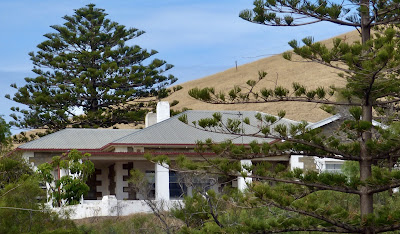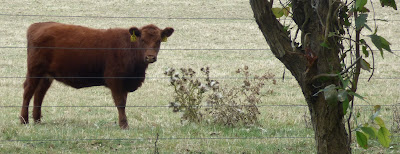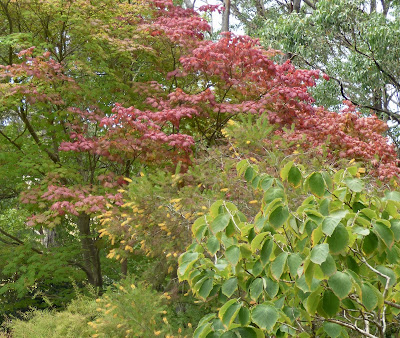It was an overcast day with just a hint of sun streaming through the occasional gap between the clouds and no wind, so we deemed it perfect for a drive to Second Valley, around 50 kms from home on the edge of the Fleurieu Peninsula where the last of the Mount Lofty Ranges edges towards the sea.
Ahh. Here was the sign pointing us to Second Valley. We stopped for a moment to take in the bucolic setting: a hint of a cottage hidden behind an exuberant planting of creepers, hedges, bushes and trees...


... the 1924 Institute next door...
... a cute cottage ...

... with me in the window!!!!
... and gorgeous cottage garden plants such as this plumbago with its delightful sky-blue flowers.
We continued on and passed through the tiny hamlet of Second Valley - the few houses can't be called anything but that - and meandered our way down to the beach. Ooops. It was a long weekend and we really hadn't figured on half of Adelaide being here. But here they were. The caravan park was full, cars clogged the road leading to the beach, there was not a space in the beach carpark and the place hummed with holidaymakers and their dogs. Humph we said and turned around and went back to the highway.
Here on the corner of the highway near the Parananacooka River is Leonards Mill, a landmark in these parts.

History alert 1: Built as a flour mill in 1858 by the Leonard brothers using local stone and steam powered by water from a well on the property, it served the community for many years until crop failures forced it to close. The mill was sold in 1877 and was used for grinding wattle bark for the tanning industry. It then languished for many years ignominiously as a shearing shed before opening as a restaurant in 1984. It's had various owners over the years but has always had a reputation for offering top-rate food using local ingredients. Here's what it looked like in the 1860s...

... and today.

It's been restored well, and the property now sits in lush gardens which we explored.

 |
| Photo courtesy of Steve because his turned out better than mine. |
We were looking forward to a coffee and cake or even a glass of bubbly on the deck, but no. A severe sign at the entrance warned us that 'Bookings are essential' and 'No teas, coffee or cakes will be served'. A woman in the bar curtly told me they weren't open until 12 o'clock. I guess virus restrictions have caused this apparent non-hospitality. It was a shame because five years ago we came here and had a scrumptious lunch and then a superb dinner for my birthday four years ago. I think the place has been sold recently so they may be struggling, but I am not sure that is the way forward.
So recovering from our second disappointment for the day, we decided to carry on to Rapid Bay a few kilometres further south. We avoided the caravan park and headed towards the jetty. I was sure the sun would come out as the day progressed. But no, the sky remained overcast. It felt still and lifeless, though out on the placid waters there were a few canoeists, kayakers and paddleboarders. You can see how dull it looked.
I wandered along the shoreline while Steve set up his lens ball.
Here's two of his shots. He loves experimenting.
I decided that I should do something creative photographically too, but there was not much opportunity. I got a bit excited when I saw the sun appear momentarily, lighting up the rocks and the far headland.
I turned around and noticed this house nestled in the foothills, surrounded by pines. What a peaceful setting. A holiday house perhaps, though I wouldn't mind living here permanently (but not on a long-weekend).
Still not entirely happy with our outing, we headed homewards with two stop-offs planned: a forest and a nursery. The forest was off the delightfully named Tapanappa Road and thickly wooded with a multitude of grass trees and stringybark eucalypts. It was peaceful, with a stillness that felt very calming; only the occasional squawky bird calls marring the quiet. For forest photography, overcast conditions are good so Steve was happy.
Once again he set to work while I wandered over and said hello to the cows - well, one in particular.
And this is Steve's forest scene.
Now, as much as I enjoyed all this I was itching to get to the nursery. Raywood Nursery is nestled deep in the heart of the stringybark forest next to the Deep Creek Conservation Park. It is in a magical setting and it felt like an adventure to get there as we drove along the twisting gravel road for what seemed like miles. It was definitely worth the effort. We parked on the verge of the forest...
... and made our way along the drive to the nursery itself. Paths meandered here and there. Trestles held a variety of plants for sale, some native, some exotic. Tiny wrens and finches darted about. Further on were enticing rows and rows of plants. All around were well-established trees and flowering shrubs. Here's a taste of what we saw.
As I was strolling along, I bumped into the owner of the nursery, Quentin (I think that was his name) Wollaston, a delightfully chatty man eager to tell his story about his ancestor Tullie Wollaston. I had recently read a book about historic gardens in the Adelaide Hills where the Wollaston family had established a home and nursery way back in the early 1900s, so I knew a little of what he told me.

History alert 2: Tullie Wollaston made his fortune through opals. In 1904 he bought a property at Bridgewater in the Adelaide Hills which he named 'Raywood' and where he planted many exotic and native trees and shrubs. On a visit to a nearby nursery in 1910 he noticed, among the rows and rows of ash tree seedlings, a seedling that looked different to the others with its claret-coloured foliage. He bought and planted it. Turns out the tree was a new variant of an ash tree and was subsequently named Claret Ash Fraxinus Raywoodii - a South Australian discovery! Tullie's grandson has kept the dream alive by establishing his own 'Raywood Nursery' in the Fleurieu Peninsula.
I didn't buy a claret ash (far too tall for the likes of our little patch), but did buy a butterfly bush that has the lovely name of Ile de France, a creeping eremophila, and an intriguing mat-like ground cover - who knows what it is but I was assured it covers the ground well and has tiny white flowers. As I was
purchasing these plants little blue wrens scampered about.
 |
| The colourful male |
 |
| and the subdued yet elegant female who sees no need to flaunt herself. |
We had a late lunch seated at a picnic table overlooking the forest, then headed home, feeling that, all in all, it had been a lovely day.






























I love how you know so much more about SA than I do! And that nursery looks fabulous. I do know Second Valley, however, and I'll email you our Easter 2018 experience of the Mill.
ReplyDeleteXXXX
I really enjoyed this adventurous day with you and Steve! I now have the urge to visit Raywood. Thanks for the inspiration 💕
ReplyDelete